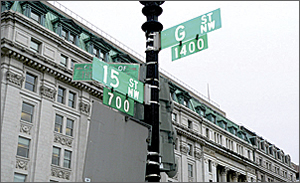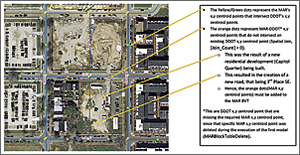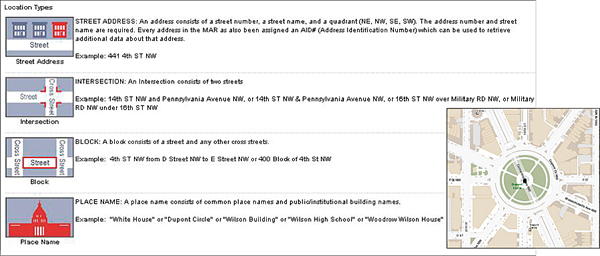Takin' It to the Streets
Updating Washington, DC's City Blocks
By Darren Murphy, GIS Analyst, District of Columbia Government
Highlights
- ArcGIS was used to develop a workflow for maintaining DC's City Block View Table.
- GIS automates the organization and analysis of a dynamic spatial dataset.
- With GIS, the final product created was new, updated, or deleted tabular records.
The City of Washington, District of Columbia (Washington, DC), is both the capital of the United States of America and a semiautonomous municipality. It is located in the mid-Atlantic region of the United States on the Potomac River and is bordered by the states of Virginia to the southwest and Maryland to the northwest, northeast, and southeast. The city is home to all three branches of the US federal government, as well as many international organizations and foreign embassies. Based on burgeoning growth of the past decade, Washington, DC, as of August 2011, had a residential population of 600,000, 140,000 addresses, 210,000 residential units, and 16,000 city blocks.
As GIS evolved from its early beginnings in the 1970s, a lot of visionary Washington policy makers and implementers with newly acquired spatially referenced planimetric data from various US federal agencies envisioned GIS as the bridge to creating robust, dynamic applications to view, understand, question, and interpret spatial relationships. Furthermore, Washington, DC's geographic information system (DC GIS) was one of the earliest adopters of Esri's GIS software technology. Out of this forged relationship came the evolution of DC GIS's current map gazetteer and its Master Address Repository-Spatial Database (MAR-SD) component, which consists of building addresses, city blocks, intersections, and other location identifiers in Washington, DC. Finally, MAR-SD serves as the cornerstone for many other mapping applications used by other District of Columbia government agencies and the residents of Washington, DC.

The Master Address Repository-Spatial Database consists of building addresses, city blocks, intersections (such as that shown above), and other location identifiers in Washington, DC. (Photos courtesy Darren Murphy.)
Spatial Data Handling—The Constant Challenge
MAR-SD consists of dynamic, spatially referenced datasets that are routinely updated to reflect the changes made within Washington, DC. One of the many datasets that compose MAR-SD is City Block View Table (CBVT), which consists of a street and any other cross streets. Specifically, MAR-SD's CBVT is updated based on changes made by the Washington, DC, Department of Transportation's (DDOT) street centerline dataset, for example, when streets are added as part of a newly approved residential development, a street is realigned, or a street is assigned a new street name.
MAR-SD's CBVT must be continuously synced with DDOT's latest street centerline dataset to provide the latest city block dataset, which is utilized by District of Columbia government agencies and applications, such as Washington, DC's Metropolitan Police Department's Sex Offender Registry mapping application.
MAR-SD is maintained by DC GIS's MAR-SD Team (MAR Team). It was tasked with revising the original manual for updating MAR-SD's CBVT. The manual essentially consisted of a series of sequential geoprocessing steps, which were to be performed individually, and all the intermediate and final datasets and was to be stored in a flat file structure. The MAR Team considered this rudimentary, disorganized, and inefficient. Within this context, the team set forth to develop a more efficient, automated workflow that facilitates the collection, organization, and spatial analysis for the above-mentioned MAR-SD CBVT dataset to reflect the changes made to DDOT's street centerline dataset. After evaluating the different options, the MAR Team decided that this GIS workflow would be accomplished through the ArcGIS modeling application.

A new residential development in the Capitol Quarter of Washington, DC, resulted in the creation of three new intersections.
Data Collection
The study area is based on the Washington, DC, political boundary, which is 177.4 square kilometers or 68.7 square miles. MAR-SD's CBVT (an Esri-based geodatabase table) and DDOT's street centerline dataset (an Esri-based geodatabase feature class) were used to create the GIS workflow.
By using ArcGIS, the MAR Team emphasized three important points regarding GIS modeling: it empowers the users to implement a linear workflow schema, it is a complete platform for delivering and sharing solutions to all end users, and the model is based on an established GIS geoprocessing framework.
For this project, it was first necessary to identify which city blocks had to be created, updated, or deleted from MAR-SD's CBVT based on the changes made to DDOT's street centerline dataset. This required a complex, sequential, two-step GIS workflow. The final product created was new, updated, or deleted tabular records. As a final note regarding the methodology, it was also essential to determine in advance the characteristics of the output dataset: is the data spatially explicit (such as a new GIS dataset) or spatially aggregated into local units (such as the US Census Bureau's census blocks)?

Visitors to the DC GIS/Master Address Repository public website portal view the various planimetric data that comprises the DC traffic grid system: blocks, intersections, addresses, and place-names (see inset above).
Results
The two interrelated GIS workflows resulted in the following updates made to MAR-SD's CBVT:
- Deletions: 9 city blocks
- New: 20 city blocks
- Updates: 14 city blocks (repositioning of the x,y coordinates)
These changes to MAR-SD's CBVT were then uploaded to the DC GIS Master Address Repository.
About the Author
Darren Murphy is a GIS analyst with the District of Columbia government, Office of the Chief Technology Officer, Master Address Repository Team. He holds a master's degree in urban and regional planning from the University of Florida and a graduate certificate in geographic information sciences from George Mason University.
For more information, contact Darren Murphy, GIS analyst, District of Columbia government (e-mail: Darren.murphy@dc.gov), or write to the District of Columbia government, Office of the Chief Technology Officer, Master Address Repository Team, 1100 15th Street NW, Washington, DC 20005.
